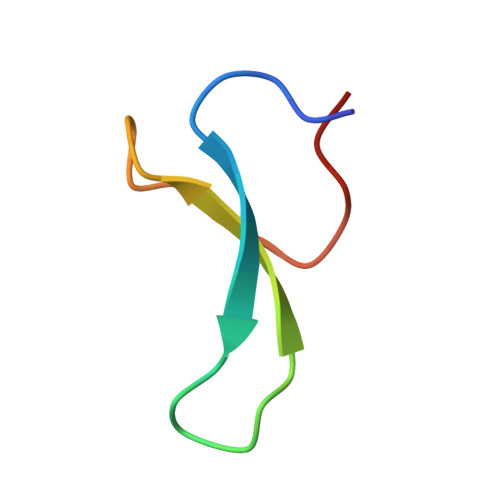Evaluation of beta-Amino Acid Replacements in Protein Loops: Effects on Conformational Stability and Structure.
Mortenson, D.E., Kreitler, D.F., Thomas, N.C., Guzei, I.A., Gellman, S.H., Forest, K.T.(2018) Chembiochem 19: 604-612
- PubMed: 29272560
- DOI: https://doi.org/10.1002/cbic.201700580
- Primary Citation of Related Structures:
5VTI, 5VTJ, 5VTK - PubMed Abstract:
β-Amino acids have a backbone that is expanded by one carbon atom relative to α-amino acids, and β residues have been investigated as subunits in protein-like molecules that adopt discrete and predictable conformations. Two classes of β residue have been widely explored in the context of generating α-helix-like conformations: β 3 -amino acids, which are homologous to α-amino acids and bear a side chain on the backbone carbon adjacent to nitrogen, and residues constrained by a five-membered ring, such the one derived from trans-2-aminocyclopentanecarboxylic acid (ACPC). Substitution of α residues with their β 3 homologues within an α-helix-forming sequence generally causes a decrease in conformational stability. Use of a ring-constrained β residue, however, can offset the destabilizing effect of α→β substitution. Here we extend the study of α→β substitutions, involving both β 3 and ACPC residues, to short loops within a small tertiary motif. We start from previously reported variants of the Pin1 WW domain that contain a two-, three-, or four-residue β-hairpin loop, and we evaluate α→β replacements at each loop position for each variant. By referral to the ϕ,ψ angles of the native structure, one can choose a stereochemically appropriate ACPC residue. Use of such logically chosen ACPC residues enhances conformational stability in several cases. Crystal structures of three β-containing Pin1 WW domain variants show that a native-like tertiary structure is maintained in each case.
Organizational Affiliation:
Department of Chemistry, University of Wisconsin-Madison, 1101 University Avenue, Madison, WI, 53706, USA.















